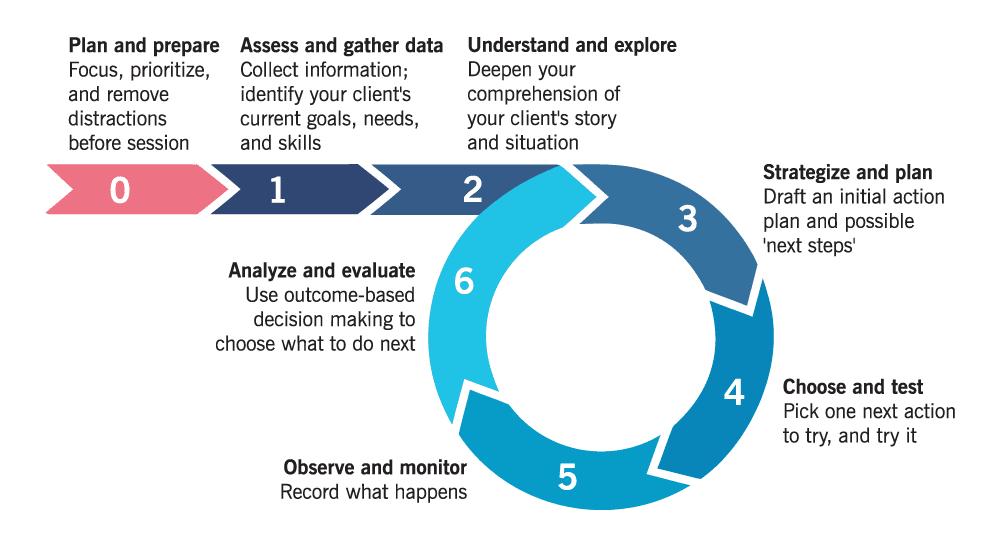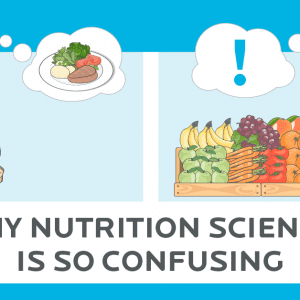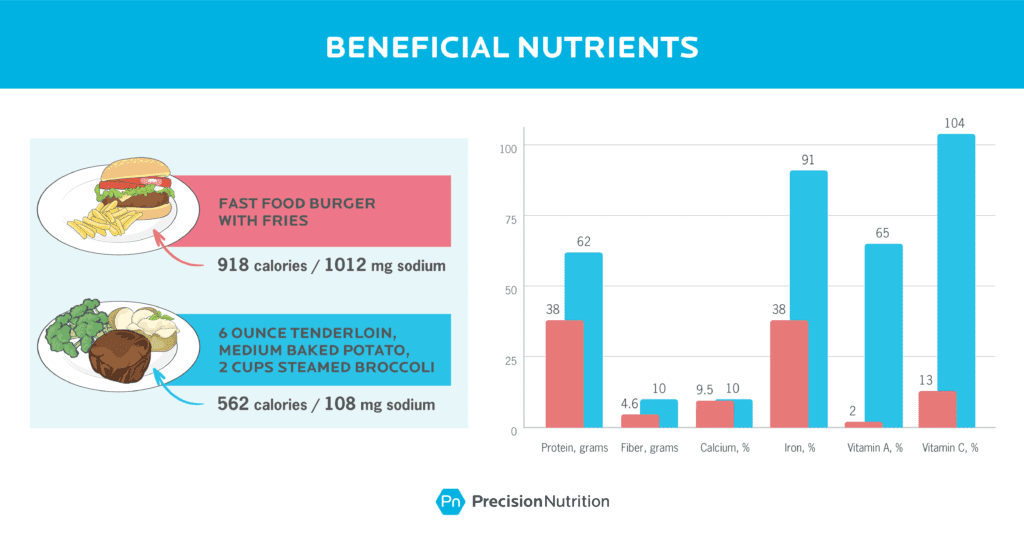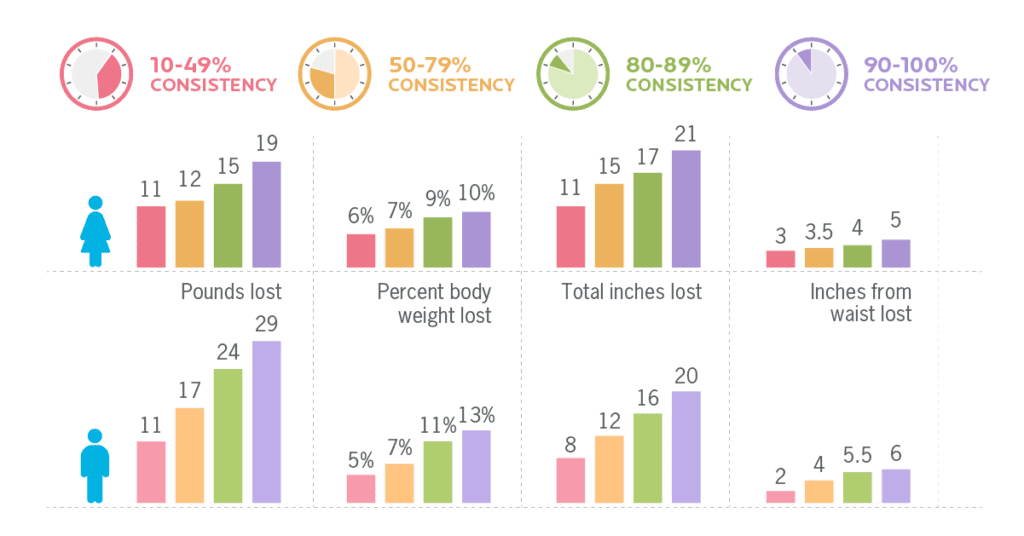“Am I doing this right?”
Self-doubt. Like a rusty sidecar on your coaching motorcycle, it rattles along next to you, no matter how long you’ve been doing this.
It might creep in when a client comes to you with a problem you’ve never dealt with before, or when a client complains, “I’ve done absolutely everything you’ve suggested—and nothing’s changed!”
Oof.
We can feel our armpits prickling too.
Here’s a secret: Even the best health-and-nutrition coaches sometimes question their skills and knowledge.
And actually, that’s a good thing.
But eventually, you do need to break those chains of self-doubt in order to help your clients figure out next actions, and be their trusted guide.
In this article, we’ll share five tools to stress-test your knowledge when you’re feeling unsure, and help you determine the best next steps for your clients.
We’ve borrowed these tools from scientists. (They’re experts in knowledge acquisition, and using what they’ve learned to inform future decisions.)
As a coach, these tools will help you feel smarter—and more comfortable facing novel coaching scenarios. Your clients will get better results. And usually, that leads to more referrals.
(In other words, everyone wins.)
Let’s learn.
(Want even more tools to feel smarter? Sign up for our FREE weekly newsletter, The Smartest Coach in the Room: Every week you’ll get helpful takeaways on the hottest nutrition and health topics and the world’s most effective coaching techniques.)
Tool #1: Get comfortable with the phrase: “I might be wrong.”
Helen Kolias, PhD, is Precision Nutrition’s science advisor.
Every week, Dr. Kollias wades into the comments of PN’s Facebook communities, offering a well-researched take on the most controversial health and nutrition topics.
What’s interesting about Dr. Kollias:
Even if someone’s assertion sounds like “the Earth is flat” quakamamie, she still checks PubMed to see if they’re onto something.
“It doesn’t matter how much I think I may already know,” Dr. Kollias says. “As a scientist, I’m trained to think, ‘Could I be wrong?’”
She does this to avoid a psychological trap known as confirmation bias: The tendency to look for and hoard information that confirms what we already believe, while simultaneously ignoring all evidence to the contrary.
To combat that bias, she and other scientists are trained to wonder, “How might I be wrong?”
And they search for evidence that supports their wrongness.
In essence, by exploring how they might be wrong, scientists are able to continually move toward what’s more right.
For coaches, embracing wrongness offers similar benefits. It helps us know, with growing confidence, what does and doesn’t work, and for which clients.
Of course, for most of us, the idea of being wrong is about as appealing as swallowing a hornet.
To get over that discomfort, we only need a little practice. Here are a few ways to do that:
- Google the opposite of what you think is true whenever you’re searching for information.
- Regularly ask, ”What if I’m wrong?” Wonder, “Are there other ways to see this situation? Where are my blindspots?” And because you can’t always see your own blindspots…
- Encourage others to oppose your opinions by saying things like, “Tell me how I’m wrong” or “I may not have all the answers, so if you know more about this than I do, I’m curious to learn.”
This is useful for clients too.
When clients say, “I can’t control myself around chocolate” or “I can’t eat sugar,” ask: “What if that’s not true?”
Help clients get past their own stuck beliefs, so they can explore what’s really possible.
Confirmation bias: Do you have it?
We have a tendency to think that confirmation bias is something that trips up… other people.
Hmm, let’s see.
Consider the following questions:
- Do you listen to people or organizations who don’t align with your health views?
- When you Google a health topic, do you click on results that disagree with what you already believe?
- Are you familiar with arguments against what you believe? For example, if you’ve embraced veganism, can you cite reasoned arguments for eating meat?
If you answered “no” to any of those questions, you might be biased, at least a little bit.
And you’re also normal.
It’s natural to seek information that confirms what we believe and ignore information that doesn’t. It’s how our minds work.
The question isn’t whether we have confirmation bias, but rather:
Are we doing anything to counter it?
Being aware of your own blind spots and regularly challenging them can dramatically widen your scope of knowledge and make you a better coach (and maybe even a better human).
Tool #2: Discern between reliable information and BS.
For more than 21 years, Alwyn Cosgrove has gathered and stored data for every single training session with clients at Results Fitness, the gym he owns in Santa Clarita, California.
“I’ve seen more workouts by 9 am on a Monday than anyone could do in a year. That’s how much information I have at my fingertips,” says Cosgrove, who also owns Results University.
That information—from roughly 40,000 yearly sessions—functions like an ongoing research study. This allows Cosgrove to make informed choices based on his own massive data set, so he can confidently answer questions like:
- If someone only has time to do one type of training, what’s more effective: power, strength, or cardio?
- What’s better for strengthening the core: crunches or stability work?
- Do clients improve faster when they work one-on-one with a trainer or when they work in small groups of four?
- Will you gain strength faster if you do shoulder presses while standing? Or while seated?
(By the way, the answers to the above questions—based on Cosgrove’s data: Power, stability work, small groups, and standing.)
Maybe you’re not like Cosgrove and you neither have decades of experience, nor hundreds of thousands of data points.
So, how do you choose the best actions for each person?
Well, a safe bet is to start with nutrition and lifestyle fundamentals that, evidence says, have the highest likelihood of creating a positive impact.
(Learn more: 5 Universal Principles of Good Nutrition—That EVERYONE Can Benefit From.)
But beyond those evergreen fundamentals, when determining the value of a new diet, exercise, or supplement, you’ll need to develop, well, a BS-meter.
There’s a lot of buzz out there about “cutting edge” ways to achieve better health. Here’s how to know what to trust:
When considering research and scientific resources…
✓ Prioritize meta analyses and reviews that summarize findings from an area of research (like Cochrane reviews), or position statements from government and nonprofit groups, like the World Health Organization, National Institutes of Health, and American College of Sports Medicine.
✓ Check the “materials and methods” section to see who participated in the study. Consider: How is your client similar to the study population? How is your client different?
✓ Look for trusted curators of research. If you’re a member of PN Academy, check out “Research Insider,” which brings you easy-to-read research summaries. Or consider subscribing to examine.com, an independent company that analyzes and summarizes nutrition research.
(Sharpen your scientific BS-meter even more: How to read a scientific study.)
When evaluating health experts…
✓ Pay more attention to seasoned pros, who have decades of experience and are still successful, and less attention to “hot” newcomers.
✓ Be wary of people who dispense advice in fields they haven’t studied. In other words, dermatologists know more about your skin than they do about your cardiovascular health.
✓ Listen to people who talk like scientists. True experts are candid about the pros and cons of various strategies, admit what they don’t know, are open-minded, and use qualifiers when they talk. See “Can you trust this expert?” below for specifics.
Can you trust this expert?
Out there in the world wide web, you can find a person, website, or study that supports almost anything.
So how do you sort the truth from fiction? Here are some hints.
| How True Experts Talk | How Non Experts Talk |
| From what we know so far, this seems to be the case, in this particular population and setting. | This is absolutely true. [Full stop.] |
| We found this result in this population, but more research is needed. We don’t know how it might affect other populations. | This is a miracle cure! This is THE answer! |
| This adds to the body of work that has shown…. | This proves it. |
| If you do this thing, you might see an improvement. On the downside… | This supplement will do EVERYTHING. There are no downsides. |
| Future research might prove this wrong. | There’s nothing that would ever change this result. |
Paradoxically, true experts may actually sound less confident than pseudo-experts.
That’s because they’re careful and take their recommendations—and the consequences of those recommendations—seriously.
They’re not completely confident, because you can’t have unbridled confidence unless you don’t know what you don’t know.
Tool #3: Know about nuance.
If you’ve been with Precision Nutrition for awhile, you’ll find we use one phrase a lot:
It depends.
How much protein do you need? It depends.
Is wine bad for you? Depends.
Should I eat more broccoli? Also… depends.
Why does so much depend? Because:
No one finding applies to all people in all situations all the time.
We know this from science:
Younger people have different protein needs than older people. Wine poses different health risks to men than it does to women. Broccoli is a great veggie choice for most people, but turns others into a fart factory.
So when considering any research finding—positive or negative—always ask:
When is this true? And when isn’t this true?
People are unique, and context matters.
Tool #4: Use experiments to test ideas.
Every year, our Precision Nutrition coaches encounter a few clients desperate to lose the last few pounds.
And often those last few pounds are based on a number from…long ago. (Maybe their wedding day weight. Or their pre-pandemic weight.)
Thing is, in addition to body weight creeping up, lots of other things have changed over the years. Like how much time someone has to devote to exercise, or how much control someone has over cookies entering the house.
Which can make that long-ago scale number a lot harder to reach.
They long for that “magic” number, but “they’re either unable to do the incredibly hard work of restricting that much—or they DO restrict a lot and still don’t lose those last few pounds,” says Precision Nutrition coach Pam Ruhland.
To these clients, Ruhland often suggests a counterintuitive experiment: Part with the scale for a month.
Surprise: Ruhland’s clients often emerge transformed, telling her, “I thought I needed to lose more weight. But I’m actually happy where I am.”
At Precision Nutrition, our coaches use experiments like the above a lot—because they help clients test strongly held beliefs that may or may not actually be true for them.
Beliefs like:
- “I’ll only be happy if I have a six-pack.”
- “If I let myself get too hungry, I’ll eat the whole fridge.”
- “This supplement is going to fix everything.”
The only way to find out if these beliefs are true, is to test them. To do so, use this advice, from Cosgrove:
✓ Know what you’re measuring, and get a baseline. Are you measuring happiness? Sleep quality? Body composition? Record your starting point, so you have something to compare to later on.
✓ Change ONE thing at a time. Scientists call this “controlling variables,” and it helps you to know what actually worked (or didn’t). So, don’t take the supplement and start doubling down on your hill sprints.
✓ Wait at least two to three weeks. Clients may step on their scale tomorrow and decide, “It’s not working! NEXT!” But caution them: It usually takes a few weeks for any intervention to have an effect.
✓ Consider graphing your data. Sometimes change isn’t perfectly linear. (Good days and bad days, you know?) Graphing helps you see visually whether things are (overall) improving, staying the same, or getting worse.
For more advice on setting up experiments, read: “3 diet experiments that can change your eating habits—and transform your body.”
Tool #5: Use failure as feedback—and not as evidence of your worthlessness.
It’s pretty rare for any scientific discovery to take place without a long, arduous process of elimination.
Katalin Karikó is a scientist at the University of Pennsylvania. Back in the 1990s, when she wanted to study how messenger RNA could be used to fight disease, no one would fund her.
No one believed her idea could work.
Undeterred, she spent decades doing experiments, most of which taught her one thing: how not to use mRNA to fight disease.
These failures proved enormously valuable: They eventually led to vaccines that have been key in fighting COVID-19.
Nutrition coaching is a similar process.
It’s frustrating when a series of actions fail to help a client move forward. But it’s precisely this process of elimination that helps clients figure out the practices that work—for them.
The more they try and test, the more they personalize nutrition, fitness, and health actions for their body, goals, and life.
To embrace this process of figuring out what works (often through valuable failure), use the 6-steps we teach our Level 1 certification students:
1. Assess and gather data.
What are your client’s goals, needs, and skills? In other words, who are they, what can they do, and what do they want? Include any baseline measurements for variables you want to track.
2. Understand and explore.
Be curious about your client’s background, story, and situation. Get to know them as a whole person, and build their trust. (Tip: Talk like a “true expert,” as mentioned above.)
3. Strategize and plan.
Hypothesize what might work most effectively for your client (based on what you uncovered in steps 1 and 2). Then, draft a plan to test that hypothesis.
4. Choose one action to try.
Drawing from the plan you’ve drafted, give your client some options, then let them choose their next action. Make sure this action is meaningful to them, and that they feel confident about their ability to do it.
5. Observe and monitor.
How well is your client able to do the thing? And how consistently? What are you and your client learning? Record how your client does, and any new information you learn about them.
6. Analyze and evaluate.
Assess how things went, based on both successes and failures. (Remember, it’s all useful feedback.) Use what you discover during this step to choose another action to move your client closer to their goal, and return to step 3.

It’s by embracing this never-ending step-by-step loop that our coaches eventually reframe failure.
Instead of labeling mistakes or lack of client results as “I’m a sorry excuse for a coach,” they come to believe: “I need to fail to learn from my mistakes.”
Feel the fear—and use science anyway.
We want you to know: It’s normal to doubt yourself, especially…
- early in your coaching career
- when facing a challenging client or situation
- when you’re not sure if your advice is actually going to work
So we’d like to leave you with two thoughts.
First, you don’t need all the answers.
What you need: a process for revealing next actions.
The five tools in this article give you exactly that. By trusting and using these science-based tools, you’ll always uncover what’s right for each client.
Second, like it or not, fear is part of this process.
As Precision Nutrition coach Jon Mills told a new coach who was struggling:
“Fear is what makes a coach great, and if we need to be without fear in order to start something new, we would never do anything.”
If you’re a coach, or you want to be…
You can help people build sustainable nutrition and lifestyle habits that will significantly improve their physical and mental health—while you make a great living doing what you love. We'll show you how.
If you’d like to learn more, consider the PN Level 1 Nutrition Coaching Certification. (You can enroll now at a big discount.)





Share